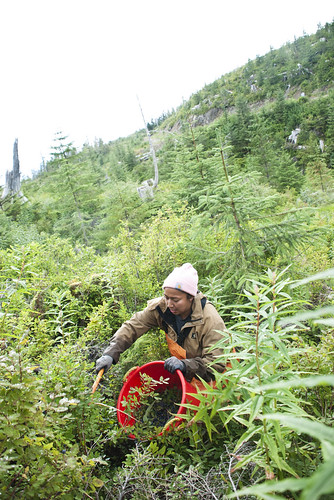
On a typical late summer day in Kake, Alaska, residents prepare for the day by layering heavy-duty rain gear, protective gloves and rubber boots over jeans and fleece. Most of these Alaskans will head to work supporting the local fishing industry. A select few, however, will be bundling up for a slightly different catch: wild organic blueberries.
Though timber and fishing have historically been the town’s economic mainstays local USDA conservation efforts have introduced the community to new, lucrative opportunities in the harvesting of local fruits. Continue reading to find out how this blueberry-based economy came into fruition for a small town of 557 inhabitants:
In 2008, with financial and technical assistance from USDA’s Natural Resources Conservation Service, the regional Alaska Native Corporation called Sealaska thinned its young-growth forests near Kake.
Thinning reduced the number of trees per acre, improving the forest condition and helping the remaining trees grow faster. It also increased the amount of light and nutrients reaching the forest floor. A greater diversity of plants in the understory enhances habitat for wildlife such as deer. One of the shrubs in the forest that benefited from more light and nutrients was the Alaskan wild blueberry.

Sealaska, which owns and manages 20,000 acres near Kake, obtained USDA organic certification for its forests, and in 2012 prices for these wild organic blueberries topped $3.10 per pound.
There is a demand for these berries from Alaskan businesses that produce value-added health products, pharmaceuticals and wine. Some people were able to harvest 200 pounds per day, earning more than $600 for a day’s work. That’s a significant wage in a town where the per capita income is just over $22,000 per year.
And locals do more than just pick blueberries. They also work in a processing center, weighing and shipping the berries. The berries are stored at a revitalized fish processing plant that has been closed for several years. So Alaskans manage and benefit from the entire operation—from the bush to the bottle!
Since 2006, NRCS has funded dozens of thinning projects in southeast Alaska. The benefits of thinning to the forest are apparent just a few years after treatment, and not just for the trees and the wildlife. Kake residents agree that this year’s berry crop was better than in the past.
With continued forest management, the blueberry business is just beginning to grow. And the indirect benefits of forest management are as sweet as blueberry pie.
Follow NRCS on Twitter.
Check out other conservation-related stories on the USDA blog.


